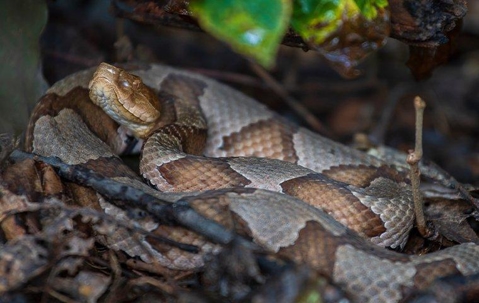A report from the Alabama A&M University Department of Forestry & Wildlife explains that approximately 40 different species of snakes are found statewide and about six of them are venomous. Snakes are predatory reptiles with long legless bodies that become most active during the warmer months. Farmers and gardeners have traditionally welcomed some types of snakes because they assist with limiting the number of unwanted rodents. To property owners, snakes are often frightening and potentially dangerous.
Venomous Snakes Found In The Region
- Copperhead: They are generally two to three feet long, have a copper-colored head, and “hourglass-like” bands. A bite may be painful but is unlikely to result in death.Cottonmouth (Water Moccasin): These are the only aquatic venomous snakes in the region. They are multicolored, may reach five feet in length, and are known for elevating their head and fully opening their mouth to reveal a white interior.
- Coral Snake: Fortunately, this dangerous species is the least common venomous snake found in Alabama. They have distinctive red, yellow, and black rings and are two to three feet long.
- Timber Rattlesnake (Banded or Canebrake Rattlesnake): They are typically multicolored with a black tail and extend from three to four feet long. These have several strains of venom, some that are quite dangerous.
- Pigmy Rattlesnake: As the name implies, they are smaller and rarely reach 30 inches in length. A bite is likely to create pain and swelling.
- Eastern Diamondback Rattlesnake: They are among the largest, reaching lengths of seven feet or more, and one of the most dangerous found in the state.
Common Non-Venomous Snakes
- Garter Snakes: The eastern garter snake rarely exceeds 30 inches and typically has head-to-tail striping.
- Water Snakes: Some types of water snakes in the region exceed three feet in length. Although they will bite, the results are mild and not fatal.
- Black or Grey Rat Snakes: They are excellent climbers and are often seen in trees.
Common Exterior Locations Where Snakes Are Encountered
Snakes on your property usually hide in areas of clutter, debris, or vegetation. Common hiding spots include holes leading underground, piles of wood or rock, and thick shrubs. They are cold-blooded creatures, meaning their body temperature is controlled by the environmental temperature. For this reason, they will move to sunny areas amid cool temperatures and shady areas during extreme heat.
Best Practices For Preventing Snakes
Snakes prefer some ground cover; therefore, it is important to keep the grass cut short. Remove unnecessary debris that can provide them hiding places, such as fallen trees or piles of rocks. Keep in mind that many snakes eat rodents, so they will commonly be attracted to areas around birdfeeders or other pests foraging through the trash. Snakes are typically an outdoor problem; still, be sure to seal any potential entry points from the foundation or exterior walls.
Responding To Problems With Snake Infestation
Property owners that begin encountering snakes on the premises must remember that these pests have the potential to be dangerous. Many retailers offer sprays, granular repellents, traps, and other products advertised as effective DIY snake control solutions. The reality is that these options are largely ineffective and are potentially harmful to humans and the environment. Contacting a qualified specialist is the best course of action. Experts with years of knowledge and expertise can accurately assess the property conditions to devise a comprehensive snake removal and prevention strategy that gets results.
Local Provider of Professional Snake Removal Services In Mobile
Our company is family-owned and operated and has been effectively solving pest control problems for more than two decades. We employ humane methods for eradicating snakes and other bothersome and potentially harmful invaders. Contact the EnSec experts today to receive a no-obligation estimate.

